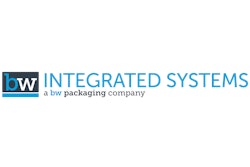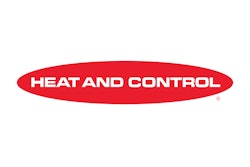When the folks at Madison’s Grand Avenue Chocolates of LaVerne, CA, decided it was time to expand their third-generation almond-growing business by penetrating the retail market with a new brand called MadiK’s, they didn’t mess around. Installed within the space of about a year were
• two vertical form fill seal systems each fed by its own combination scale
• a horizontal form fill seal system also fed by a combination scale, and
• a tray-filling/cartoning line anchored by two advanced robotic pick-and place-machines.
The vertical and horizontal form fill seal systems are used to package nuts in flexible film that includes a metallized polyester layer that delivers the necessary oxygen barrier. Both vertical form/fill/seal systems are Ishida Atlas units from Heat and Control. Above each of these baggers is an Ishida 14-bucket combination weigher also supplied by Heat and Control. The firm also supplied the Fastback vibrating conveying pans that bring product from processing to packaging. Both pillow-style pouches holding 1 or 2 oz and tube-style pouches holding 1.5 oz are produced by these two baggers. A Videojet thermal-transfer coder on each vertical bagger handles date coding.
A few feet away from the two vf/f/s systems is a Mespack Model H260FE horizontal f/f/s system from AlliedFlex. Like the vertical baggers, it pulls film from a roll and produces flexible packages. But these are larger portions of nuts weighing 5.5 or 11 oz. They’re also gusseted stand-up pouches rather than lay-flat pillow-style pouches, and they have roll-fed zipper material applied to them on-line so that the pouch is recloseable. The three form/fill/seal machines all share the same nut delivery system. Provided by Heat and Control, it’s a system of vibrating pans that can deliver nuts to any one of the three baggers or to all three at once.
One of the striking things about the Mespack system, which is a walking-beam style of machine, is its length: 33 feet. But it’s a wonder it isn’t a few feet longer when you consider how many things need to happen between beginning and end, including these:
• Seal zipper profile onto film
• Pull film over forming collar
• Side sealing
• Punch for the V-notch that permits formation of the gusset at the bottom
• Filling (aided by vacuum cups that come in contact with the film from opposite sides and stroke back out to open the bag nice and wide)
• Top sealing
• Punch for peg hole
In addition to the above, there are three different points at which nitrogen bursts are introduced as a way of purging oxygen and thus extending shelf life. One is just before filling, one is right after filling, and a third coincides with the dropping of the nuts into the freshly formed pouch.
The Mespack system, which operates at about 52 pouches/min, can be quickly changed from the 5.5- to the 11-oz pouch because it uses the same width for both pouch sizes. Only the pouch height needs changing.
Robots down the road
About a mile down the road from the facility in which Madison’s does its pouch filling is a robotic packaging operation that was launched a year or so ahead of the pouch business. This is where Madison’s produces chocolate-covered almond clusters and packs them in plastic trays that in turn go into paperboard cartons.
The clusters themselves consist of a dollop of molten chocolate, six or so almonds, and then another dollop of chocolate. Shortly after the second deposit of chocolate, the finished clusters spend 12 minutes in a cooling tunnel. Exiting the tunnel, the clusters reach a pair of Quattro robots from Adept that sit between a left and right conveyor belt. The first robot picks clusters from a central conveyor and places them into trays that are conveyed along the right side of the robots. The second robot concentrates on putting clusters into trays on the left conveyor. Thethermoformed trays have 6, 9, or 12 cavities, and the robots can be quickly adjusted to handle all three.
The Quattro is a parallel robot like the Delta-style robots that are used in so many packaging operations like Madison’s. But the Quattro differs from these three-armed systems in that it features four-arm kinematics. This permits higher speeds, faster accelerations, and an expanded work envelope.
Mario Jaramillo, vice president and chief operating officer at Madison’s, says the speed of the Quattro was a key consideration. The two Quattro robots have a combined speed of 200 picks/min. Without the robots in the line, anywhere from two to six operators at $27,000 to $30,000 annually would be required to put clusters into trays. And repetitive-motion injuries would doubtless be an issue.
Pick-and-place systems
Assisting in the automated process of getting clusters into trays are two pick-and-place units from Thiele. These machines use vacuum pickup cups to pull trays from a magazine and place them on the conveyor belts that run beneath the two robots.
Once the trays are filled with almond clusters, they exit the robot cell and make a right angle turn onto a conveyor from which operators manually pick them and load them into two-piece telescoping cartons. The paperboard tops and bottoms of the cartons are formed automatically by a Model SLS70D carton-erecting system from Switchback Group. Side-by-side magazines hold simplex lock-style carton bottoms and carton tops. With each cycle, the Switchback machine erects and places one bottom and one top on a conveyor that leads to a station where operators load trays of almond clusters into the carton bottoms and then cover the bottoms with the tops. The operators stack two 6-cavity trays, two 9-cavity trays, or two 12-cavity trays in each carton.
Another right angle turn in the work flow now takes cartons through a Loma metal detector, a Citronix ink-jet date coder, and a Marden Edwards overwrap machine. “The overwrapper pulls clear film from a roll and wraps it around each carton,” says Jaramillo. “It’s not a shrink film, just a heat seal at one edge of the carton. It’s a pretty neat machine.”
The last two pieces of equipment in the line are a Belcor case erector and a Belcor case taper from Wexxar. Operators load cartons by hand into cases erected by the Bel 505 case erector and then send the filled cases through the Bel 150 case taper.
Looking back over the very busy two years that have just come to a close, Jaramillo acknowledged that a lot of companies in Madison’s shoes might have chosen a contract packager to get them launched into retail channels. But he believes the path that he and his colleagues have chosen is the best one for them.
“It’s our trees, our almonds, our product, our brand, and our processing and packaging equipment,” says Jaramillo. “It’s all controlled by one company, and we had a clean slate when it came time to launch it all.”


































